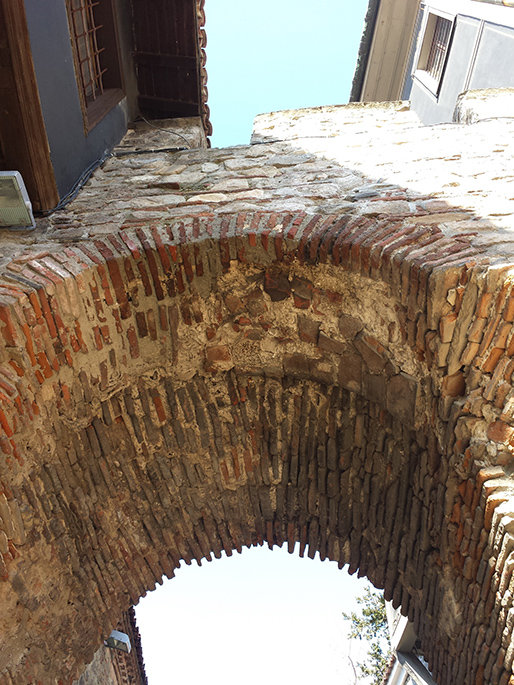Hisar Kapia on:
[Wikipedia]
[Google]
[Amazon]
Hisar Kapia is a medieval gate in
 The first gate on this place was built in the 2nd century AD. In the 6th century during the rule of
The first gate on this place was built in the 2nd century AD. In the 6th century during the rule of
Image:EastGatePlovdiv.jpg
Image:Хисар капия.JPG
Image:Хисаркапия -източен вход на крепостта.JPG
Image:Хисар капия Hisar kapia.JPG
Image:Лунната пътека с поглед през Хисар капия.JPG
Image:Nigth in Plovdiv 04.jpg
Plovdiv
Plovdiv ( bg, Пловдив, ), is the second-largest city in Bulgaria, standing on the banks of the Maritsa river in the historical region of Thrace. It has a population of 346,893 and 675,000 in the greater metropolitan area. Plovdiv is the c ...
's old town and one of the most famous tourist sights in the city. The gate was built in the 11th century AD over the foundations of a gate from Roman times (probably from the 2nd century AD). Hisar Kapia is one of the three entrances (Eastern, Northern and Southern) to the acropolis
An acropolis was the settlement of an upper part of an ancient Greek city, especially a citadel, and frequently a hill with precipitous sides, mainly chosen for purposes of defense. The term is typically used to refer to the Acropolis of Athens, ...
of ancient Plovdiv
Plovdiv ( bg, Пловдив, ), is the second-largest city in Bulgaria, standing on the banks of the Maritsa river in the historical region of Thrace. It has a population of 346,893 and 675,000 in the greater metropolitan area. Plovdiv is the c ...
. During the rule of the Ottoman empire
The Ottoman Empire, * ; is an archaic version. The definite article forms and were synonymous * and el, Оθωμανική Αυτοκρατορία, Othōmanikē Avtokratoria, label=none * info page on book at Martin Luther University) ...
revival houses were embedded in the remains of the old stone walls around the gate.Strandel, Leslie/Patrick Erdley (2012): "Bulgaria (Other Places Travel Guide)", 234
History
 The first gate on this place was built in the 2nd century AD. In the 6th century during the rule of
The first gate on this place was built in the 2nd century AD. In the 6th century during the rule of Justinian
Justinian I (; la, Iustinianus, ; grc-gre, Ἰουστινιανός ; 48214 November 565), also known as Justinian the Great, was the Byzantine emperor from 527 to 565.
His reign is marked by the ambitious but only partly realized ''renovat ...
the fortification system of the ancient town was expanded and the gate was strengthened. Archeologist suggest that only the foundations of the ancient Roman gate were preserved. The current structure of Hisar Kapia was formed in the Middle Ages (13th - 14th century AD). A construction technique typical from the Second Bulgarian Empire
The Second Bulgarian Empire (; ) was a medieval Bulgarians, Bulgarian state that existed between 1185 and 1396. A successor to the First Bulgarian Empire, it reached the peak of its power under Tsars Kaloyan of Bulgaria, Kaloyan and Ivan Asen II ...
is visible over the arch: a masonry of stones and brick pieces, filled with white mortar.
The importance of the gate faded after the Ottoman invasion in the 14th century. In the 17th and 18th century the rich merchants of Plovdiv built their houses over the ruins of the fortification walls around Hisar Kapia. Today, the lower levels of those houses represent the remains of the ancient walls. Hisar Kapia was reinforced in the beginning of the 20th century due to its poor condition.Kay, Annie (2008): "Bulgaria. The Bradt Travel Guide", 223
Today, the medieval gate is one of the landmarks of Plovdiv
Plovdiv ( bg, Пловдив, ), is the second-largest city in Bulgaria, standing on the banks of the Maritsa river in the historical region of Thrace. It has a population of 346,893 and 675,000 in the greater metropolitan area. Plovdiv is the c ...
Gallery
References
{{Ancient Monuments in Plovdiv Roman sites in Bulgaria Tourist attractions in Plovdiv History of Plovdiv Medieval Bulgarian architecture